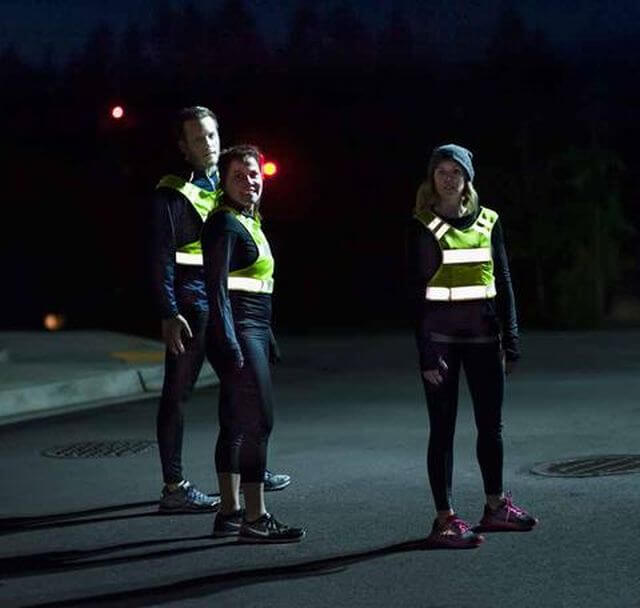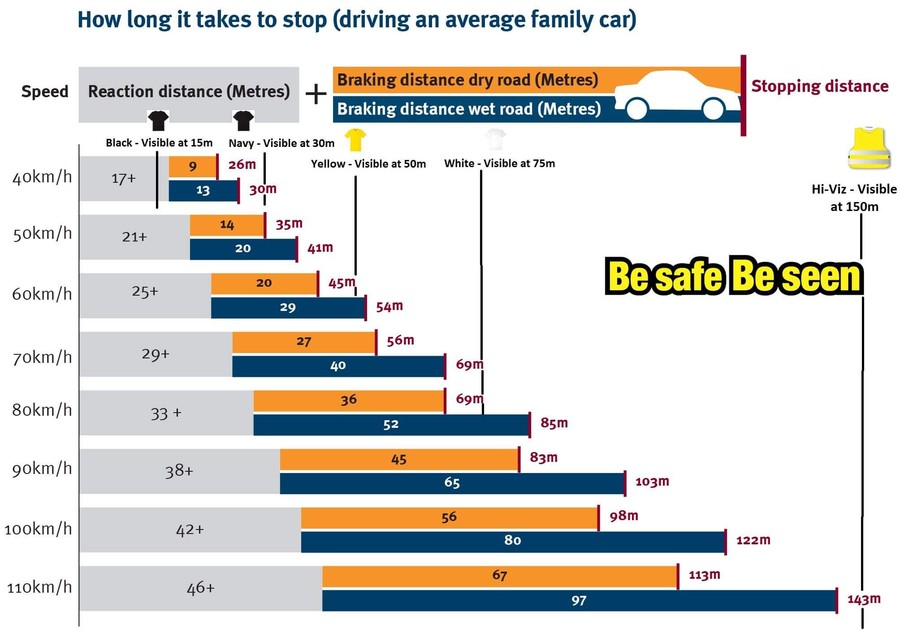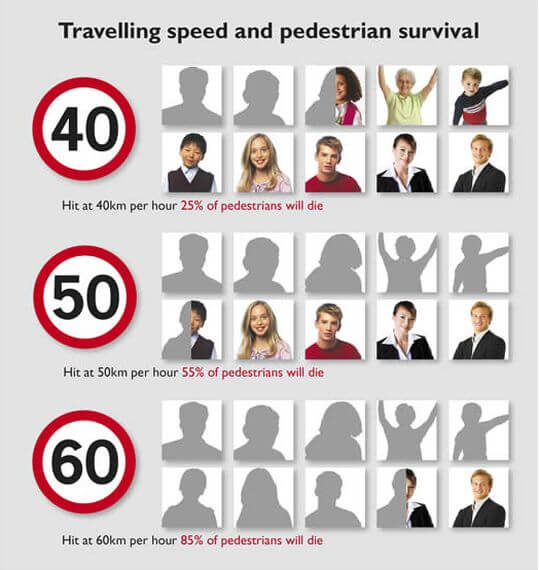Running Safely in the Dark
Running or Walking at Night - Be Safe - Be Seen!
Running Safely....It's No Accident!
Updated October 21st 2023



| Car Speed | Conditions | Reaction Distance | Braking Distance | Total | Black Visible at 15m | Dark Visible at 30m | Yellow Visible at 50m | White Visible at 75m | Hi- Viz Visible at 150m |
|---|---|---|---|---|---|---|---|---|---|
| 40 kph | Dry | 17m+ | 9m | 26m |  | Seen | Seen | Seen | Seen |
| 40 kph | Wet | 17m+ | 13m | 30m |  |  | Seen | Seen | Seen |
| 50 kph | Dry | 21m+ | 14m | 35m |  |  | Seen | Seen | Seen |
| 50 kph | Wet | 21m+ | 20m | 41m |  |  | Seen | Seen | Seen |
| 60 kph | Dry | 25m+ | 20m | 45m |  |  | Seen | Seen | Seen |
| 60 kph | Wet | 25m+ | 29m | 54m |  |  |  | Seen | Seen |
| 70 kph | Dry | 29m+ | 27m | 56m |  |  |  | Seen | Seen |
| 70 kph | Wet | 29m+ | 40m | 69m |  |  |  | Seen | Seen |
| 80 kph | Dry | 33m+ | 36m | 69m |  |  |  | Seen | Seen |
| 80 kph | Wet | 33m+ | 52m | 85m |  |  |  |  | Seen |
| 90 kph | Dry | 38m+ | 45m | 83m |  |  |  |  | Seen |
| 90 kph | Wet | 38m+ | 65m | 103m |  |  |  |  | Seen |
| 100 kph | Dry | 42m+ | 56m | 98m |  |  |  |  | Seen |
| 100 kph | Wet | 42m+ | 80m | 122m |  |  |  |  | Seen |
| 110 kph | Dry | 46m+ | 67m | 113m |  |  |  |  | Seen |
| 110 kph | Wet | 46m+ | 97m | 143m |  |  |  |  | Seen |
Even if you're Dead Right - There's no point in ending up Just as Dead as if you were Wrong!
The above infographic and table vividly demonstrate the value of wearing Hi-Viz clothing when running or walking in dark and low-light condtions.
Remember! These are best case conditions - If a driver is impaired by drink or drugs, or on their mobile phone, the quoted stopping distances may be increased very significantly.
Many people, wrongly, think that Yellow or White tops are adequate for them to be seen. Clearly Hi-Viz, which can be seen at 150m, is the safest option.....BUT even then, every runner needs to take responsibility for their own safety....Be Ready for the Unexpected!
As for anyone wearing dark clothing, even in lit, built up areas, at night ....get a Hi-Viz! It's a No-Brainer!
What A Driver Sees at Night
- More than two-thirds of fatal pedestrian collisions happen at night. Although you can hear a car coming and see its lights, the driver may not see you (and certainly won’t hear you).
- Be seen. Wear high-visibility, brightly colored clothing. When out near or after sunset, reflective materials are a must. (If you don't own reflective clothing, a lightweight reflective vest is a great option.
- Use a headlamp or handheld light so you can see where you're going, and drivers can see you. The light should have a bright LED (drivers see blinking red as a hazard).
- Don't assume a driver sees you. In fact, imagine that a driver can't, and behave accordingly. Think that you're invisible.
- Face traffic. It’s easier to see, and react to, and evade, oncoming cars. Drivers will see you more clearly too. It's also easier to see (and react to) any mistake an advancing motorist may make.
- Make room. If traffic gets heavy, or the road narrows, be prepared to move onto the footpath or shoulder of the road.
- Unplug your ears. If you insist on using iPods or wearing headphones—you need to be able to hear approaching vehicles, run with the volume low and just one earbud in.
- Beware of high-risk drivers. Steer clear of potential problem areas like entrances to garages, carparks, bars, and restaurants, where there may be heavy traffic.
- Watch for early birds and night owls who have not cleared frost or morning dew off their windshields; they may not be able to see you. At odd hours be extra careful. Early in the morning and very late at night, people may be overtired and not as attentive.
- Mind your manners. At a stop sign or light, wait for the driver to wave you through—then acknowledge with your own polite wave. That acknowledgement will make the driver feel more inclined to do it again for the next walker or runner. Use hand signals (as you would on a bicycle) to show which way you plan to turn.
- Never cross at a bend
- If possible, cross at a pedestrian crossing or traffic lights
- Always carry some form of identification, also include information on allergies, blood group, medical fund and contact number for next of kin.
- Write down or leave word of the direction of your run. Tell friends and family of your regular running routes.
- DON'T assume, just because you have right of way, that the driver/biker/cyclist has seen you. They may be distracted by mobile phones, are on drugs/drink, running the red lights, or whatever. Be alert at all time! YOU are responsible for YOUR OWN safety!

The RSA supply Hi-Viz Running vests, along with lots of other Hi-Viz items FREE OF Charge.
No excuses! Get yours NOW!
For large orders, from the likes of clubs, you may need to make special arrangements with the RSA
If you don't want to wait for delivery, just get down to your local bike or sports store, even toy shops sell them! Of course you will have to pay for them...but it could well be the best money you've ever spent!
How to Stay Safe When Running At Night
The most important element in staying safe when running at night is to see and be seen. Increasing your visibility lets drivers see you. Stay visible and alert at all times. The following tips are important at all times, but they are vital at night and at other times of low visibility.
1. Pay Attention to Your Surroundings
It’s vital that you pay attention to what’s happening around you. Make note of others on the road, including cars, cyclists, pedestrians, fellow runners, and the more recent hazard - electric scooters ...Very often used without lights or Hi-Viz AND coming at you at speed! Don’t wear headphones or earbuds when you run, or, maybe, wear them in one ear only. You need to be able to hear approaching cars, sirens, people anything out of the ordinary. If you feel that you must listen to something, pick a podcast or audiobook. Music can drown out noise, listening to a voice will probably still allow you to hear things happening around you
2. Keep It Simple
Think local, insteady of doing a long loop, maybe doing two or more shorter laps closer to home, so that you aren’t too far from home in the dark
3. Run Against Traffic
Running on the right-hand side of the road is one of the best ways to give drivers a clearer view of what’s in front of them, and also enables you see what’s coming at you. Try to avoid running during rush hour, or along busy roads. If you can, run on less-congested routes. Run on the footpath, if there is one, instead of the road. Probably the least safe thing is to run on the road on the left-hand side. You have NO Idea what's happening behind you...and you have No Chance of taking evasive action!
4. Wear Bright and Reflective Clothing
Colors such as white, orange and yellow are good for running in the dark, but are far less effective than reflective materials, which are at least twice as good. Your gloves, hats and shoes should all have reflective properties, too. You can also wear a headlight, or chest lights, or on your arms, and some Hi-Viz vests have built-in LED lights
5. Run Behind Cars at Junctions
You can be a defensive runner by assuming drivers aren’t looking out for you, and remembering to look out for them. Run behind cars at junctions, not in front. The driver might not have seen you and could pull out while you are in front of their car. The lead driver at a junction is likely to be looking out for his chance to pull out. Running behind vehicles also helps keep traffic moving and causes less confusion. When you come to an junction, try to make eye contact with the drivers there, to confirm that they see you. If you believe that they havent seen you, or if you see that they are distracted, take extra care
6. Change Your Route
Changing up your route can be a good idea, as it can reduce the risk of being mugged - don't be predictable. Always make sure you are familiar with the route before you set out, so you don’t get lost. It's a good idea to have several different courses, and change them during the week
7. Run With a Friend
It’s more fun, and safer, to run with a friend or or a group, and there is less chance of a confrontation with a stranger when you’re with someone else
8. Run in Well-Lit Areas and/or Use Night Running Lights
Running in well lit areas helps to be seen by pedestrians and other road users, and helps you see too. If you don't have this option to run in a lit area, you should use some sort of night running lights. Lightweight LED cap or vest lights can give you with the visibility you need to see properly while running at night
9. Dress Appropriately
Wearing layers helps you avoid getting overheated or being too cold during a run. Wear clothing made of moisture-wicking material closest to your body. The fabric should pull sweat away from you so you don’t become too cold as your sweat dries. Moisture-wicking fabrics, such as technical fabrics or wool, are also more comfortable to wear
If you run on a chilly night, wear gloves and a beanie
11. Use a Night Running App
If you got lost or need assistance, some apps and/or watches have features that notify your emergency contacts. For example, if you’re feeling scared, you’re injured or you're lost, you can just tap a button on an app to send a message to a contact
12. Carry Your ID and Your Phone
It's a good idea to carry some sort of ID when running, especially if you are running somewhere strange, e.g When on holidays.Tuck your ID or contact into your pocket or carry an ID tag when you go for a run at night - it's a good idea to do this by day too. Emergency responders and medical professionals can use your ID to determine who to contact if you are injured or unconscious. You might think about carrying your phone with you too, even if you aren’t using an app. You can use it to call for help if needed. You might want to put emergency information into your phone, such as an “in case of emergency” (ICE) contact. Another option is to write out emergency instructions on a card and carry it with your phone and ID
13. Gear up With Smart LED Technology
You might find yourself in a situation where you want more light during a nighttime run. Wearable LEDs light the path ahead, while keeping your hands free. A hat, vest or beanie, with a built-in light, keeps the path ahead lit, even if a street lamp has burnt out or other lights aren’t available












